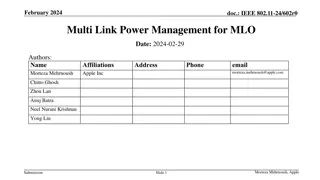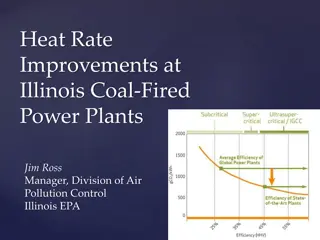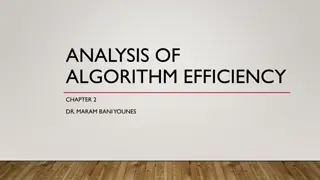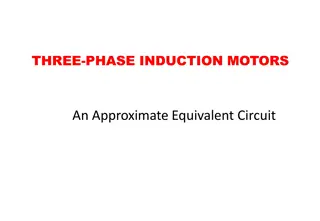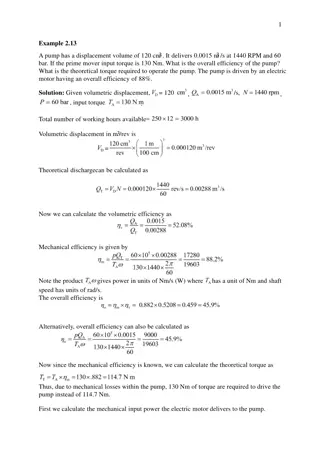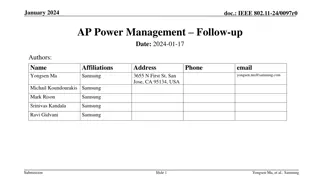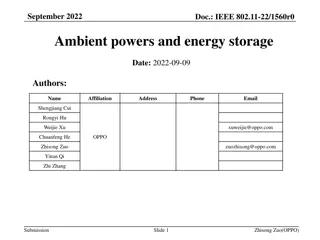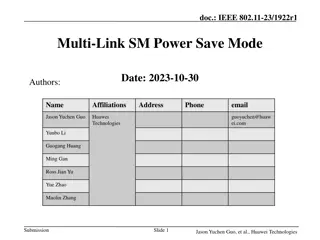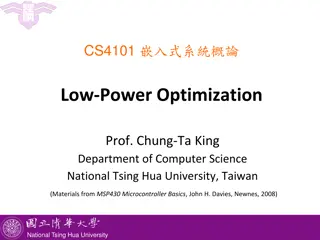
Improving AP Power Management Efficiency
Requirements and recommendations to enhance energy efficiency of Access Points (APs) in IEEE 802.11 networks are discussed. Various protocols and options are explored for AP power savings without impacting functionality and performance negatively.
Download Presentation

Please find below an Image/Link to download the presentation.
The content on the website is provided AS IS for your information and personal use only. It may not be sold, licensed, or shared on other websites without obtaining consent from the author. If you encounter any issues during the download, it is possible that the publisher has removed the file from their server.
You are allowed to download the files provided on this website for personal or commercial use, subject to the condition that they are used lawfully. All files are the property of their respective owners.
The content on the website is provided AS IS for your information and personal use only. It may not be sold, licensed, or shared on other websites without obtaining consent from the author.
E N D
Presentation Transcript
November 2023 doc.: IEEE 802.11-23/1835r0 AP Power Management Date: 2023-09-01 Authors: Name Yongsen Ma Affiliations Samsung Address 3655 N First St, San Jose, CA 95134, USA Phone email yongsen.ma@samsung.com Michail Koundourakis Samsung Mark Rison Samsung Srinivas Kandala Samsung Ravi Gidvani Samsung Submission Slide 1 Yongsen Ma, et al., Samsung
November 2023 doc.: IEEE 802.11-23/1835r0 Abstract There are requirements and recommendations to improve the energy efficiency of APs. There are protocols and options in existing IEEE 802.11 specifications and proposals in the next generation 802.11bn UHR for AP power save. AP power save protocols should be carefully designed to avoid any negative impact on functionality and performance for IEEE 802.11 networks. This contribution considers options for AP power save while limiting the negative impact on APs and non-AP STAs. Submission Slide 2 Yongsen Ma, et al., Samsung
November 2023 doc.: IEEE 802.11-23/1835r0 AP Power Management In IEEE 802.11bn, there are requirements to improve the energy efficiency of 802.11 APs [1, 2, 3, 4], especially for Soft AP/Mobile Hotspot/Mobile AP running on battery-device [13, 14] Some APs also would be idling or in low duty cycle mode during certain time of the day: Socket powered APs/home APs: early mornings APs in enterprise/office/industrial environments: off-work hours APs in stadiums/shopping malls: outside of operating hours Having the ability to reduce power consumption would be helpful in preserving battery for Soft/Mobile APs and be more eco-friendly for socket powered, home and enterprise APs. There are some protocols/options from existing IEEE 802.11 specifications and UHR proposals for AP power save [5, 6, 7]. Power save protocols for APs should be carefully designed to avoid functionality and performance degradation. A fundamental requirement for the AP is that it shall always be on, so that Clients are able to scan, find the AP and associate Have data communication There are trade-offs between power save levels and performance requirements for AP power save. Submission Slide 3 Yongsen Ma, et al., Samsung
November 2023 doc.: IEEE 802.11-23/1835r0 Related Work Existing protocols for non-AP STA power save PS-Poll, SMPS (static, dynamic), PSMP (Power Save Multi-Poll), TXOP PS TIM, TIM segmentation, DTIM, ATIM, APSD (unscheduled, scheduled) TWT (individual, broadcast, trigger-based, restricted), RAW (Restricted Access Window), WUR, Existing protocols for AP power save Limit the channel width, MCS, # antenna, NSS [6] Limit the 802.11 generation/version/feature Power control, sensitivity control Scheduled PS for APs in S1G [5, 6] Scheduled and unscheduled PS for AP or PCP in PBSS and DMG infrastructure BSS Other options/proposals for AP power save BSS Termination (AP power down notification) [9]; 802.11ba WUR and Wake Up AP [11, 12] RAW/S-APSD/TWT with limited SP or Listen Interval [13, 14], then the AP turns into doze state Current UHR proposals for AP power save Unscheduled AP PS and utilize MLD: certain link in active mode and other links in PS mode [5, 6, 7] Scheduled AP PS: TWT-based duty cycling for APs [6, 14]; dynamic AP PS: SMPS/EMLSR for APs [6] AP always in Awake state AP may be in Doze state on certain link(s) Submission Slide 4 Yongsen Ma, et al., Samsung
November 2023 doc.: IEEE 802.11-23/1835r0 AP Power Save challenges Goal: Challenges: Need to ensure that legacy devices are operable AP able to respond to probe requests, serve on-demand data, and latency sensitive traffic Proposal: Define AP Power Save mechanism through adjustment of the AP s schedule & capability Different power states to support different power save levels and performance requirements Power state transition and capability information to provide different trade-off options Options for APs and STAs to interrupt/update/request/report/adjust/feedback/ the power save mode/level/schedule To improve the energy efficiency of APs while limiting the negative impact on functionality and performance Submission Slide 5 Yongsen Ma, et al., Samsung
November 2023 doc.: IEEE 802.11-23/1835r0 AP Power Save Proposal: Overview The AP balances power save levels and performance requirements by adjusting its schedule & capability. In the scheduled time window, the AP may be in Doze state: The AP sends Absence Notification in Beacon, Probe Response, or Action frames to other STAs. The AP remains in the doze state and is absent during the scheduled time window. Listen state: The AP remains in the listen state performing CCA or signal detection. The AP may respond to legacy devices or on-demand data in deferred or immediate manners. Reduced capability: The AP may use a reduced capability subset, such as single antenna, reduced BW, lower MCSs, etc., instead of utilizing the full capability set. Submission Slide 6 Yongsen Ma, et al., Samsung
November 2023 doc.: IEEE 802.11-23/1835r0 AP Power Save Proposal: Absence Notification AP may use absence notification and go into a power save mode transitioning between an awake and a doze state Absence notification can be published by AP in beacon, probe response, and action frames The intention is to provide predictable and periodic behaviors, to ensure smooth network operations Potential Issues: STAs need to know the awake/doze schedule of the AP. Otherwise following issues may arise Legacy device may lose connectivity [8, 9] Other connectivity issues: STAs unable to scan, temporary loss of synchronization; high roaming delay Performance issues: longer delay for network scanning, discovery, association; reduced throughput; higher packet loss rate; reduced efficiency, inaccurate/inefficient link adaptation, increased congestion, QoS/latency sensitive data may not be served in a timely manner Slide 7 Submission Yongsen Ma, et al., Samsung
November 2023 doc.: IEEE 802.11-23/1835r0 AP Power Save Proposal: Power State Transition To address the potential issues introduced by Absence Notification, APs can stay in Listen state with different power state transition capabilities. Compared with Doze state, APs in Listen state may have less power saving, introducing less functional capability and performance degradation. APs in Listen state may respond to on-demand data requirements and change the schedule, or exit the PS mode early and respond immediately. APs and non-AP STAs have options to influence the schedule APs may use different schedule parameters such as duration, interval, count, power state, power state transition capability, etc., to balance power saving and performance requirements. APs may change the schedule based on network conditions, traffic volume, amount of power consumption reduction, functionality and performance, etc. Non-AP STAs may indicate their presence information in Probe Request or Action frames to influence the schedule and may send Schedule Request to obtain the most recent schedule. Submission Slide 8 Yongsen Ma, et al., Samsung
November 2023 doc.: IEEE 802.11-23/1835r0 AP Power Save Proposal: Summary Outside/inside of the scheduled time window (see slide 6) Impact on power saving and performance Can support or can be supported by legacy APs/STAs Power Mgmt. Mode outside inside Power save level Performance degradation Support for legacy STAs and on-demand data Supported by legacy APs Power State Power State Transition Doze (Absent) radio off*: not able to transmit, receive, listen, or update the buffer High High No No Cannot be interrupted: cannot switch to TX state to respond until the next available Awake state. May switch to RX state to update the buffer Medium to High Partially Supported*** Power Save Mode Medium Partial Support** Listen Awake Can be interrupted: can switch to TX state to respond ASAP Low to Medium Low to Medium Yes Yes Can switch to TX/RX/Listen state, capability adaptation with reduced capability, e.g., SISO and non-HT mode Low to Medium Low to Medium Partially Supported*** Partial Support* Awake Active Mode Can switch to TX/RX/Listen state, with full capability None None Yes Yes radio off*: may or may not use WUR Partial Support**: can support in terms of functionality, but may have reduced performance in certain scenarios Partially Supported***: legacy APs can support, but other STAs may not be aware or may not be able to understand Submission Slide 9 Yongsen Ma, et al., Samsung
November 2023 doc.: IEEE 802.11-23/1835r0 Information Elements Schedule information, e.g., interval, duration, start time, count. May reuse existing elements such as Schedule element and/or existing functions such as TWT Capability information power state info: doze state, listen state, or awake state with reduced capability power state transition info: if in listen state (or WUR) not interruptible, or interruptible. If interruptible, o the whole schedule o or only the current time window To indicate/notify whether operating w/ reduced capability: a subset of the full capability, e.g., single antenna, non-HT, reduced BW, low MCSs, low power listening mode [15], etc. May reuse existing procedures such as Operating Mode Indication/Notification Schedule info and capability info can be in separate IEs or in a single IE. Submission Slide 10 Yongsen Ma, et al., Samsung
November 2023 doc.: IEEE 802.11-23/1835r0 Example 1: Transitions between Absent and Awake states The AP can specify the schedule and send Absence Notification in Beacon, Probe Response, or Action frames STAs that can receive & decode the schedule may change to Doze state when the AP is absent Submission Slide 11 Yongsen Ma, et al., Samsung
November 2023 doc.: IEEE 802.11-23/1835r0 Example 2: Presence Request from STAs STAs can send Presence Request to influence the schedule of the AP The AP shall send the new schedule in Beacons The AP may send the new schedule in Action frames during the Awake state based on the previous schedule Submission Slide 12 Yongsen Ma, et al., Samsung
November 2023 doc.: IEEE 802.11-23/1835r0 Example 3: Transitions between Awake and Listen states The AP can stay in Listen state to be aware of legacy devices, Presence Request and STA availability of data If the AP receives Presence Request or indication of availability of data: The AP may respond to a presence request STAs with the new schedule in the next available Awake state, or exit the Listen state early and respond to STAs immediately The AP shall send the new schedule in Beacons to other STAs During the scheduled Awake state, the AP can send Presence Response in Action frames to other STAs by unicast/broadcast Submission Slide 13 Yongsen Ma, et al., Samsung
November 2023 doc.: IEEE 802.11-23/1835r0 Conclusion A brief summary of existing protocols for non-AP STA power save, and existing protocols/options and 802.11 UHR proposals for AP power save A proposal of scheduled AP power save to improve the energy efficiency of APs while limiting the negative impact on functionality and performance Absence Notification allowing APs to be absent for certain time periods Capability options allowing APs to respond to legacy devices and on-demand data with different urgency requirements Power state transition capability Capability adaptation with reduced capability Scheduling options allowing APs/STAs to interrupt/update/request/report/adjust/feedback/... the schedule in different scenarios such as different network conditions/requirements, power saving requirements, and tolerance of functional & performance degradation Submission Slide 14 Yongsen Ma, et al., Samsung
November 2023 doc.: IEEE 802.11-23/1835r0 References [1] Dorothy Stanley, Liaison statement from Wi-Fi Alliance re: energy efficiency, IEEE 802.11-23/0917r0, 2023 [2] Amelia Andersdotter, et al., 802.11 AP Power Save PAR addition proposal, IEEE 802.11-23/0244r1, 2023 [3] Amelia Andersdotter, et al., Green AP and resilience requirements for home networks, IEEE 802.11-22/1790r0, 2022 [4] Lili Hervieu, et al., A Perspective on UHR Features for Operator Residential Deployments, IEEE 802.11-22/1809r0, 2022 [5] Liwen Chu, et al., AP MLD power management, IEEE 802.11-23/0015r0, 2023 [6] Alfred Asterjadhi, et al., Considerations for enabling AP power save, IEEE 802.11-23/0010r0, 2023 [7] Guogang Huang, et al., Considering Unscheduled AP Power Save, IEEE 802.11-23/0225r0, 2023 [8] Po-Kai Huang, et al., WUR Operating Channel, IEEE 802.11-17/1333r2, 2017 [9] Allan Thomson, ap power down notification, IEEE 802.11-08/0947r2, 2008 [10] Stefan Aust, AP Power Saving, IEEE 802.11-11/0046r2, 2011 [11] Stefan Aust, TGah Use Case AP Power Saving in Smart Grid, IEEE 802.11-11/0273r0, 2011 [11] Xiaofei Wang, et al., AP Power Saving, IEEE 802.11-17/0728r2, 2017 [12] Xiaofei Wang, et al., On AP Power Saving Usage Model, IEEE 802.11-17/1388r2, 2017 [13] Jay Yang, et al., MLD AP Power-saving(PS) Considerations, IEEE 802.11-20/1115r6, 2020 [14] Kyumin Kang, et al., Considerations on Soft AP Power Saving, IEEE 802.11-21/0885r1, 2021 [15] Xiaogang Chen, et al., Low Power Listening Mode, IEEE 802.11-22/1414r1, 2022 Submission Slide 15 Yongsen Ma, et al., Samsung



